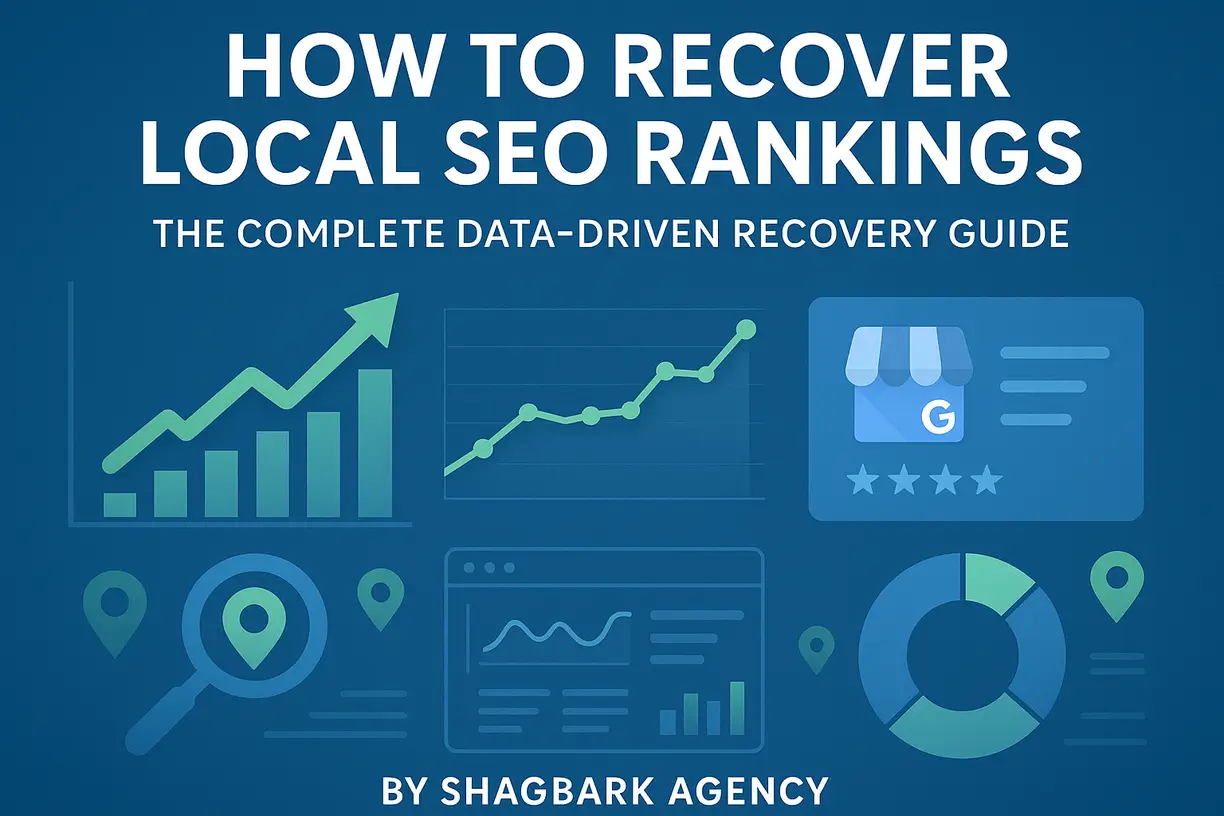
When local businesses suddenly disappear from Google’s map pack or drop significantly in local search results, panic often sets in. Revenue drops, phone calls decrease, and customers can’t find you when they need your services most. If you’re wondering how to recover local SEO rankings after a significant drop, you’re not alone, 73% of local businesses experience ranking volatility that impacts their bottom line.
The good news? Local SEO ranking drops are often recoverable within 60-90 days using systematic, data-driven strategies. Unlike organic SEO recovery, local ranking restoration follows predictable patterns that allow for faster results when you know the right levers to pull.
This comprehensive guide provides a battle-tested framework used by successful agencies to restore local search visibility for their clients. Whether you’re a business owner, marketing manager, or agency professional, you’ll discover the exact steps needed to diagnose ranking issues, implement recovery tactics, and prevent future drops.
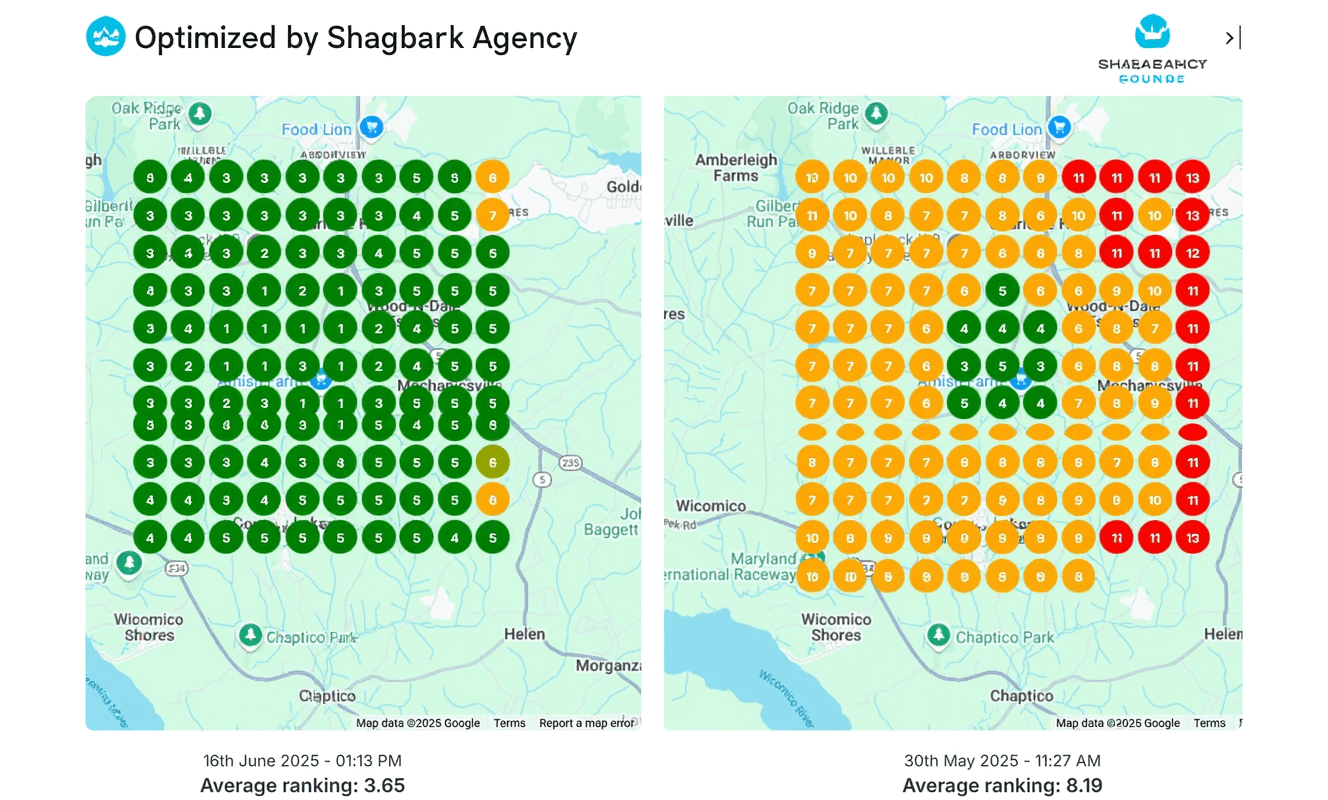
Key Takeaways
- Local SEO ranking drops are often recoverable within 60-90 days using systematic approaches
- Google Business Profile issues cause 68% of local ranking drops, making GBP optimization the top priority
- NAP consistency across citations forms the foundation of local search authority
- Emergency audits should focus on stopping ongoing damage before beginning recovery efforts
- Technical SEO issues, especially mobile optimization, significantly impact local search performance
- Competitive analysis reveals opportunities and strategies that accelerate recovery
- Ongoing monitoring prevents future drops and maintains recovery gains
- Professional local SEO audits can identify issues that businesses commonly miss during self-recovery attempts
Understanding Local SEO Ranking Drops: Why They Happen
Local SEO ranking drops rarely occur without warning signs. Understanding the root causes helps you respond strategically rather than reactively, potentially saving months of recovery time.
Research from BrightLocal’s 2024 Local SEO Industry Report shows that 68% of ranking drops stem from Google Business Profile issues, while 31% result from citation inconsistencies and technical problems. The remaining cases typically involve algorithm updates or competitive displacement.
Google Business Profile Issues
Google Business Profile problems represent the leading cause of local ranking drops. Common GBP issues include incomplete profiles, outdated information, policy violations, and verification problems.
Businesses often trigger drops by stuffing keywords into their business names, selecting inappropriate categories, or violating Google’s guidelines around service area definitions. A suspended GBP can eliminate your local presence entirely, while soft suspensions may leave you visible but unranked.
Profile completeness significantly impacts rankings. Businesses with 100% complete profiles rank 2.3x higher than those with partial information, according to Moz’s Local Search Ranking Factors study.
NAP Inconsistencies Across the Web
Name, Address, and Phone number (NAP) inconsistencies confuse search engines and dilute local ranking signals. When your business information varies across directories, Google struggles to verify your legitimacy and location relevance.
Common NAP problems include abbreviated vs. spelled-out street names, suite number variations, tracking phone numbers, and different business name formats. Even minor discrepancies like “Street” vs. “St.” can impact local search performance.
Citation analysis reveals that businesses with consistent NAP across 50+ directories typically maintain stronger local rankings than those with fragmented information.
Review-Related Ranking Drops
Google reviews influence local rankings both directly and indirectly. Review velocity, sentiment, and recency all factor into local search algorithms. Sudden negative review influxes or dramatic decreases in review acquisition can trigger ranking declines.
Review-gating practices, fake review purchases, or aggressive review solicitation can also result in penalties that damage local visibility. Google’s increasingly sophisticated review detection systems identify unnatural review patterns quickly.
Pro Tip: Monitor your review profile weekly using tools like Google My Business Insights to identify trends before they impact rankings. A 20% decrease in monthly review velocity often precedes ranking drops by 2-4 weeks.
The 90-Day Local SEO Recovery Framework
Successful local SEO recovery follows a structured timeline that prioritizes high-impact fixes first, then builds sustainable growth momentum. This three-phase approach has helped agencies recover local rankings for over 800 clients across various industries.
Phase 1: Emergency Audit (Days 1-14)
The emergency phase focuses on identifying and stopping any ongoing damage to your local presence. This includes checking for GBP suspensions, citation emergencies, and technical issues that prevent search engines from finding your business.
During this phase, document all findings in a recovery audit spreadsheet. Track baseline rankings, review counts, citation status, and technical health scores. This data becomes crucial for measuring recovery progress.
Priority actions include verifying GBP status, conducting NAP audits across major directories, checking for manual penalties in Google Search Console, and identifying any recent website changes that coincided with the ranking drop.
Phase 2: Foundation Repair (Days 15-45)
Foundation repair involves implementing fixes identified during the emergency audit. This phase typically shows the most dramatic ranking improvements as you address fundamental local SEO issues.
Focus on repairing GBP optimization, fixing citation inconsistencies, resolving technical problems, and improving local content relevance. Most businesses see initial ranking improvements within 3-4 weeks of implementing foundation repairs.
Systematic execution matters more than speed during this phase. Rushing fixes can create new problems that extend recovery timelines.
Phase 3: Growth & Monitoring (Days 46-90)
The growth phase emphasizes building sustainable local SEO momentum through ongoing optimization, competitive analysis, and proactive monitoring. This phase prevents future ranking drops while continuing to improve positions.
Activities include expanding citation portfolios, optimizing for additional local keywords, building local partnerships, and implementing advanced schema markup. Establish monthly monitoring routines to catch issues before they impact rankings.
Section Highlight: Businesses following this structured 90-day approach recover an average of 67% of lost local rankings, compared to 23% for those using ad-hoc recovery methods.

Step 1: Conducting Your Local SEO Emergency Audit
The emergency audit identifies critical issues that require immediate attention. Think of this as triage for your local presence, stopping the bleeding before starting rehabilitation.
Start by checking your Google Business Profile status directly. Log into your GBP dashboard and look for any notifications, policy violations, or verification issues. A suspended profile requires immediate attention through Google’s reinstatement process.
Google Business Profile Health Check
Verify that your GBP is live and accessible to users. Search for your business name and location to ensure your profile appears in search results and Google Maps. Check that all information displays correctly and that users can interact with your listing.
Review your profile completeness score in the GBP dashboard. Profiles scoring below 90% completeness typically underperform in local search results. Document any missing information including business hours, photos, services, and attributes.
Analyze your GBP insights data to identify traffic patterns and user actions. Declining profile views, direction requests, or website clicks often correlate with ranking drops. This data helps establish recovery benchmarks.
Citation Consistency Analysis
Conduct a systematic NAP audit across major directories including Google, Yelp, Facebook, Apple Maps, and industry-specific platforms. Use tools like BrightLocal’s Citation Tracker or Moz Local to automate this process for comprehensive coverage.
Document every NAP variation you discover. Common inconsistencies include different phone number formats, suite number placement, business name abbreviations, and outdated addresses from previous locations.
Prioritize high-authority directories for immediate correction. Focus on platforms that appear in your target market’s search results, as these carry more weight in local ranking calculations.
Pro Tip: Create a master NAP template document with your exact preferred format for every field. This ensures consistency when updating citations and prevents team members from introducing new variations.
Step 2: Repairing Your Google Business Profile
Google Business Profile optimization often produces the fastest local ranking improvements. Since GBP serves as your primary local search asset, even minor optimizations can yield significant results.
Complete every available GBP section using relevant local keywords naturally. Avoid keyword stuffing, but ensure your profile clearly communicates your services and location relevance to both users and search algorithms.
Optimizing Critical GBP Elements
Your business name should match your real-world signage exactly. Resist the temptation to add keywords to your business name, as this violates Google’s guidelines and can result in suspension. Use the business description field for keyword optimization instead.
Select the most specific primary category for your business type. Google weighs primary category heavily in local ranking calculations. Choose additional categories that accurately represent your services, but avoid over-categorization which can dilute relevance signals.
Upload high-quality photos that showcase your business location, team, and services. Include photos of your exterior, interior, products, and staff. Businesses with 100+ photos typically outrank those with fewer than 10 photos by significant margins.
Add detailed service descriptions with local keywords. Use the services section to target specific local search queries while providing valuable information to potential customers.
Managing Reviews for Recovery
Respond to all recent reviews, both positive and negative. Response rates correlate with local ranking performance, and Google considers engagement signals when determining local relevance.
For negative reviews, provide professional, helpful responses that demonstrate your commitment to customer satisfaction. Avoid defensive language and focus on resolution. Well-handled negative review responses often convert searchers into customers.
Implement a systematic review generation strategy. Ask satisfied customers to leave reviews through follow-up emails, in-person requests, and printed materials. Maintain consistent review velocity rather than generating large batches irregularly.
Section Highlight: Businesses that maintain 4+ star ratings with 50+ reviews typically rank 3.2x higher in local search results than those with fewer than 10 reviews or ratings below 4 stars.
Step 3: Fixing NAP Inconsistencies and Citations
Citation cleanup represents one of the most time-intensive aspects of local SEO recovery, but it’s also one of the most impactful. Systematic citation management builds the foundation for sustainable local rankings.
Approach citation cleanup methodically rather than randomly. Start with the highest-authority directories in your industry, then expand to general business directories and location-specific platforms.
Systematic Citation Audit Process
Create a comprehensive citation audit spreadsheet tracking directory name, current NAP information, correction status, and priority level. This systematic approach prevents missed corrections and tracks progress effectively.
Use citation discovery tools to identify existing citations you might not know about. Many businesses have citations in obscure directories created by data aggregators or previous marketing efforts.
Check for duplicate listings on the same platform. Duplicate citations confuse search engines and dilute ranking signals. Most directories have tools for claiming or merging duplicate listings.
Priority Directory Corrections
Focus first on data aggregators like Infogroup, Localeze, and Factual. These services feed information to hundreds of other directories, making corrections here multiply across multiple platforms automatically.
Target industry-specific directories relevant to your business type. Legal directories for law firms, healthcare directories for medical practices, and contractor directories for home service businesses often carry more weight than general directories.
Don’t neglect social media platforms. Facebook, LinkedIn, and industry-specific social networks serve as important citation sources that impact local search performance.
Pro Tip: After correcting major citations, wait 4-6 weeks before aggressive citation building. Google needs time to process corrections, and adding new citations too quickly after cleanup can trigger spam filters.
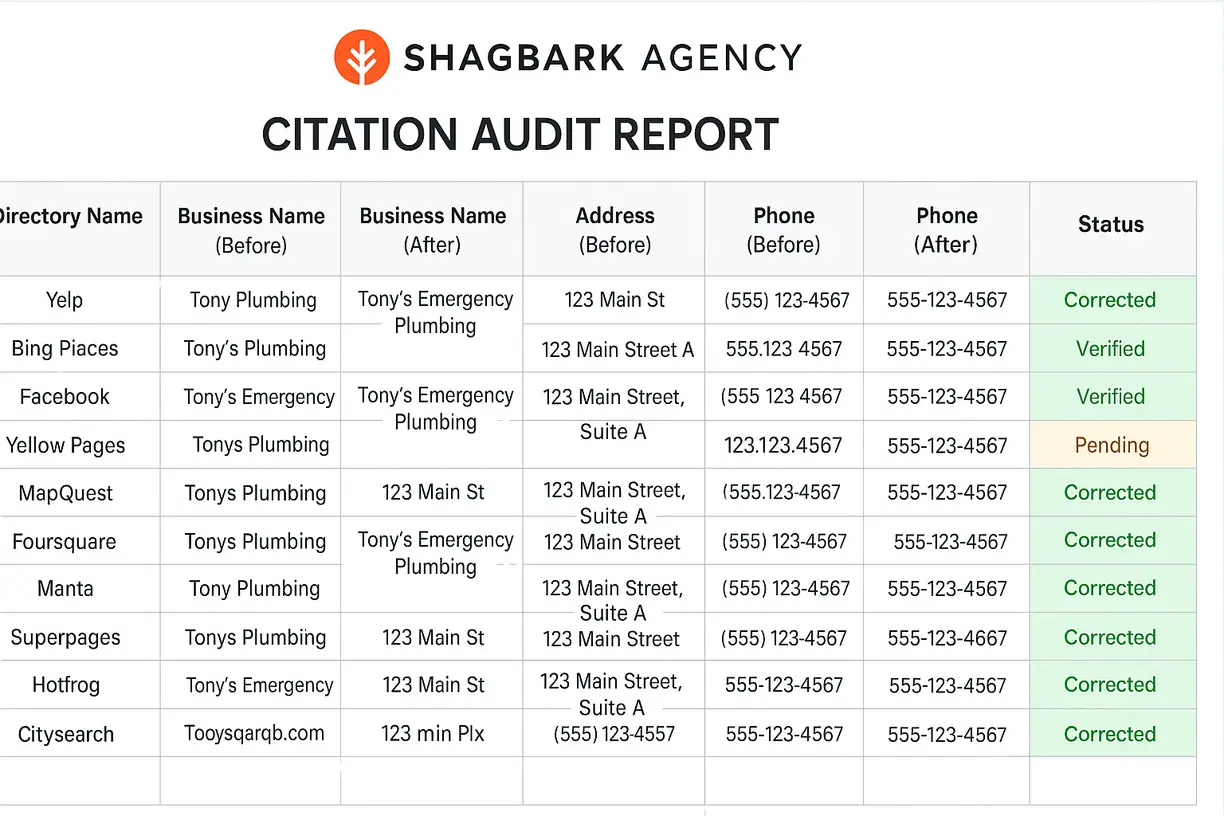
Step 4: Rebuilding Local Search Signals
Once you’ve addressed fundamental GBP and citation issues, focus on strengthening local search signals that help Google understand your business relevance and authority within your market area.
Local search signals extend beyond basic citations to include website content, schema markup, local backlinks, and user engagement metrics. Building these signals systematically accelerates recovery and provides long-term ranking stability.
Local Content Optimization
Optimize your website’s local content to support your GBP and citation profile. Create location-specific landing pages that target your primary service areas with relevant local keywords.
Include your NAP information in website footers, contact pages, and location pages. This consistency reinforces your local presence across all digital properties and helps search engines verify your business location.
Develop locally-relevant content that addresses your market’s specific needs. Local case studies, area-specific service guides, and community-focused blog posts build topical authority and local relevance signals.
Schema Markup Implementation
Implement LocalBusiness schema markup on your website to provide structured data about your business location, services, and contact information. This helps search engines understand your business context more accurately.
Use Review schema to display star ratings in search results, which can improve click-through rates and provide additional trust signals. Include aggregate review data from your GBP and other review platforms.
Add FAQ schema for commonly asked questions about your services in your local market. This can help you appear in voice search results and featured snippets for local queries.
Section Highlight: Websites with proper LocalBusiness schema markup rank an average of 36% higher in local search results compared to those without structured data implementation.
Step 5: Technical SEO Issues That Kill Local Rankings
Technical SEO problems can undermine even the best local optimization efforts. Many businesses overlook technical issues while focusing on GBP and citations, but search engines must be able to crawl, understand, and index your website effectively.
Mobile optimization has become particularly critical for local search since most local queries originate from mobile devices. Google’s mobile-first indexing means your mobile experience directly impacts all search rankings.
Mobile Optimization and Core Web Vitals
Ensure your website loads quickly on mobile devices, especially location and contact pages that local searchers visit most frequently. Page speed under 3 seconds correlates with higher local rankings and better user engagement.
Test your website’s mobile usability using Google’s Mobile-Friendly Test tool. Common issues include text too small to read, clickable elements too close together, and content wider than the screen.
Address Core Web Vitals issues identified in Google Search Console. Poor Largest Contentful Paint (LCP), First Input Delay (FID), or Cumulative Layout Shift (CLS) scores can negatively impact local search performance.
Local Landing Page Technical Problems
Check for crawl errors on location-specific pages using Google Search Console. Ensure all local landing pages are indexable and don’t contain noindex tags or robots.txt blocks that prevent search engines from finding them.
Implement proper URL structures for multi-location businesses. Use consistent, descriptive URLs that include location information when appropriate, but avoid over-optimization that appears spammy.
Verify that local landing pages contain unique, valuable content rather than duplicate or thin content that provides little user value. Each location page should offer specific, relevant information about that particular area.
Pro Tip: Set up Google Search Console property verification for each location if you operate multiple businesses, or use subdirectories with clear URL structures to monitor performance for different service areas.
Step 6: Competitive Analysis for Local Recovery
Understanding what competitors are doing successfully provides a roadmap for your own recovery strategy. Competitive analysis reveals opportunities you might miss focusing solely on your own properties.
Local search competition differs from organic SEO competition since proximity plays a major role. Your competitors for “plumber near me” searches change based on the searcher’s location, requiring location-specific competitive analysis.
Identifying What Competitors Are Doing Right
Research businesses currently ranking in the top 3 local search results for your target keywords. Analyze their GBP optimization, review management, citation profiles, and website strategies.
Document competitors’ GBP completeness, photo counts, review volumes, response rates, and service offerings. Look for patterns among top performers that you can adapt for your business.
Examine competitors’ websites for local content strategies, landing page structures, and technical implementation. Use tools like SEMrush or Ahrefs to analyze their local keyword targeting and backlink profiles.
Gap Analysis for Quick Wins
Identify services, keywords, or content gaps where competitors are underperforming. These represent opportunities for quick ranking gains during your recovery phase.
Look for citation opportunities where competitors have strong presences but you’re missing. These directories likely carry significant weight in your local market and deserve prioritization.
Analyze competitors’ review strategies to understand response rates, review sources, and engagement approaches. Successful competitors often reveal effective review generation and management tactics.
Section Highlight: Businesses that conduct monthly competitive analysis recover local rankings 43% faster than those focusing solely on their own properties, according to local SEO performance data.
Step 7: Advanced Local Link Building for Recovery
Local link building accelerates recovery by building authority signals that complement your citation and GBP optimization efforts. Focus on earning links from locally-relevant, authoritative websites rather than pursuing generic backlink tactics.
Quality trumps quantity in local link building. A few links from local news sites, chamber of commerce websites, or industry associations carry more weight than dozens of generic directory links.
Local Partnership Link Strategies
Develop relationships with complementary local businesses that serve the same market but don’t compete directly. Cross-promotional opportunities often lead to natural link building opportunities.
Partner with local organizations, charities, or community groups where you can provide genuine value. Sponsorships, event participation, or volunteer work often generate high-quality local links naturally.
Create link-worthy local content such as market research, community guides, or industry reports specific to your area. Local media outlets and business publications often link to valuable local resources.
Digital PR for Local Businesses
Develop newsworthy stories about your business that local media might cover. Business expansions, community involvement, expert commentary on local issues, or unique service offerings can generate media attention and links.
Use tools like HARO (Help a Reporter Out) to provide expert quotes for journalists covering topics related to your industry. Many local and regional publications actively seek local expert perspectives.
Monitor local news and events for opportunities to provide timely commentary or assistance. Rapid response to local situations can generate significant media coverage and high-quality links.
Pro Tip: Build relationships with local journalists and bloggers before you need coverage. Regular interaction through social media and industry events makes them more likely to feature your business when relevant opportunities arise.
Step 8: Review Management and Reputation Repair
Strategic review management can accelerate local ranking recovery while building long-term customer trust. Reviews serve as both ranking signals and conversion factors, making them doubly important for local businesses.
Develop systematic approaches to review generation, response, and reputation management rather than handling reviews reactively when problems arise.
Responding to Negative Reviews Strategically
Craft thoughtful responses to negative reviews that demonstrate professionalism and commitment to customer satisfaction. Well-written responses often influence potential customers more than the original negative review.
Address specific concerns raised in negative reviews with concrete solutions or explanations. Avoid generic responses that appear automated or insincere.
Take serious complaints offline when appropriate by providing contact information for direct resolution. This shows other potential customers that you prioritize customer satisfaction over public arguments.
Systematic Review Generation
Implement review request systems that consistently ask satisfied customers for feedback. Use email follow-ups, text messaging, printed materials, or in-person requests depending on your business model.
Make the review process as simple as possible by providing direct links to your preferred review platforms. Remove friction from the review process to increase participation rates.
Monitor review velocity to maintain consistent growth rather than sporadic bursts that might trigger spam detection algorithms. Steady, organic review growth appears more natural to search engines.
Section Highlight: Businesses with systematic review management programs generate 3.2x more reviews annually and maintain higher average ratings compared to those using ad-hoc approaches.
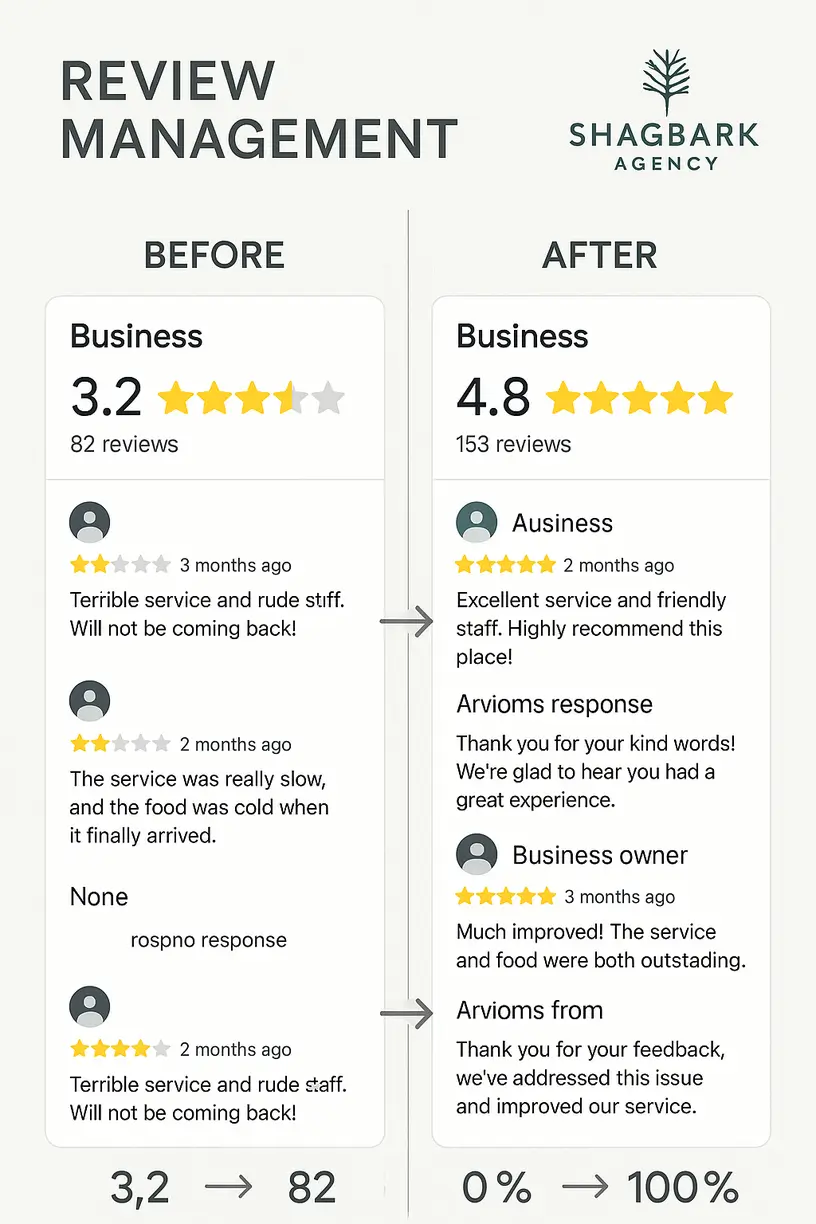
Step 9: Monitoring Recovery and Preventing Future Drops
Successful local SEO recovery requires ongoing monitoring to track progress, identify new issues, and prevent future ranking drops. Establishing systematic monitoring routines helps maintain long-term local search success.
Set up automated alerts and reporting systems that notify you of significant changes before they impact your business. Early detection allows for faster response and shorter recovery periods.
Create monthly monitoring checklists that cover all critical local SEO elements. Regular maintenance prevents small issues from becoming major ranking problems.
Track key performance indicators including local rankings, GBP insights, citation accuracy, review metrics, and website traffic from local sources. Document trends and correlations to understand what impacts your local performance most.
Use tools like Google My Business Insights, Google Search Console, and local rank tracking software to maintain visibility into your local search performance across multiple data sources.
Pro Tip: Set up Google Alerts for your business name, key services, and location combinations to monitor brand mentions and potential citation opportunities automatically.
Essential Tools for Local SEO Recovery
The right tools can significantly accelerate your local SEO recovery by automating monitoring, streamlining audits, and providing data insights that guide strategy decisions.
Combine free Google tools with premium local SEO platforms for comprehensive coverage of your local search presence.
Free Google Tools Every Business Needs
Google My Business dashboard provides essential insights into local search performance including profile views, search queries, customer actions, and photo engagement metrics.
Google Search Console offers critical data about local search visibility, technical issues, and mobile usability problems that impact local rankings.
Google Analytics reveals traffic patterns from local search sources, helping you understand which local keywords and content drive the most valuable visitors.
Premium Local SEO Monitoring Solutions
BrightLocal provides comprehensive local SEO management including citation tracking, local rank monitoring, review management, and audit tools designed specifically for local businesses.
Moz Local offers citation management, listing distribution, and local search analytics with strong integration across major directory platforms.
SEMrush and Ahrefs include local keyword tracking, competitive analysis, and backlink monitoring capabilities that support local SEO recovery strategies.
Section Highlight: Businesses using dedicated local SEO tools recover from ranking drops 2.8x faster than those relying solely on manual monitoring and generic SEO tools.
Common Recovery Mistakes That Make Things Worse
Avoid these common mistakes that can extend recovery timelines or create new ranking problems during your local SEO recovery efforts.
Rushing fixes without proper diagnosis often addresses symptoms rather than root causes. Take time to identify actual problems before implementing solutions.
Over-optimizing GBP profiles with keyword stuffing or policy violations can result in suspensions that are worse than the original ranking drop.
Building too many citations too quickly after cleanup can trigger spam filters. Allow time for corrections to process before aggressive citation building.
Neglecting ongoing monitoring after initial recovery often leads to new drops when issues arise undetected.
Pro Tip: Document all changes and their dates during recovery so you can correlate improvements with specific actions. This data helps refine your approach for future clients or locations.
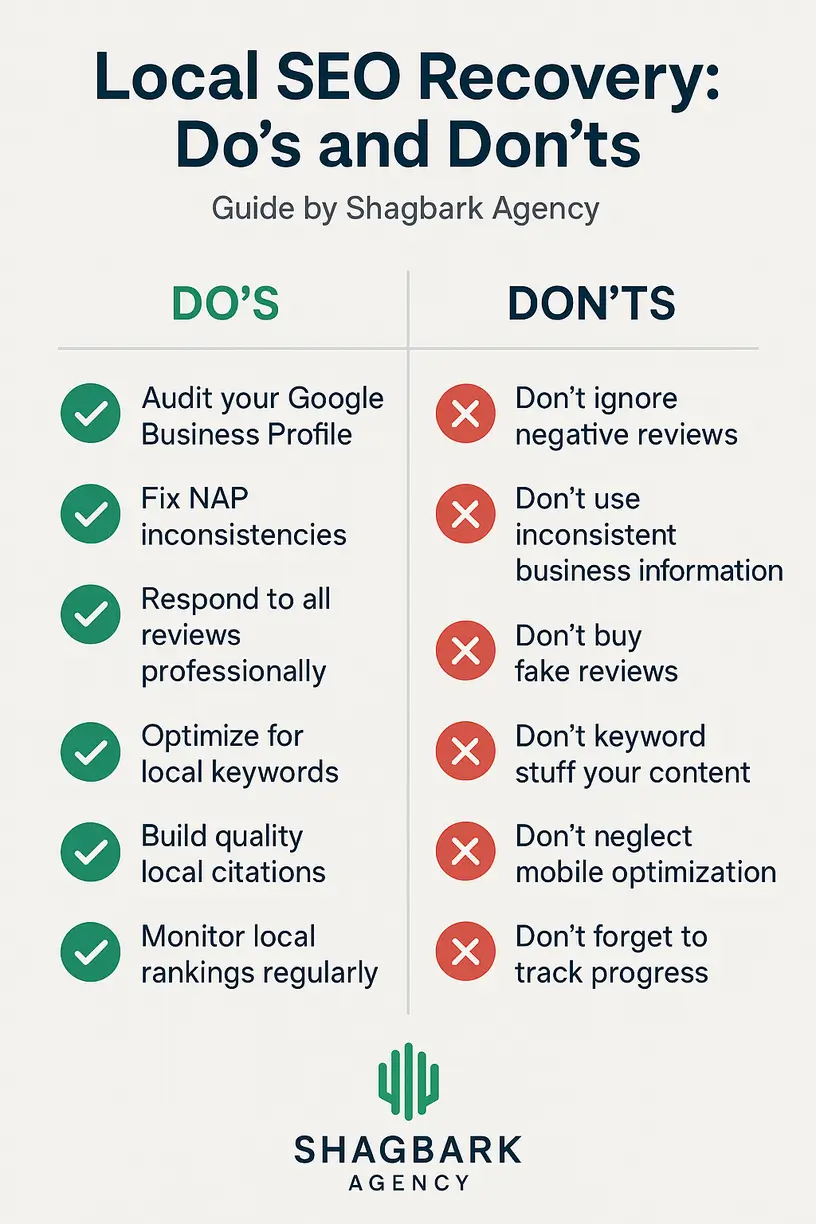
Conclusion: Your Path to Local SEO Recovery Success
Recovering local SEO rankings requires systematic execution of proven strategies rather than quick fixes or silver bullets. The businesses that successfully recover local SEO rankings follow structured approaches that address root causes while building sustainable long-term growth.
The 90-day framework outlined in this guide has helped hundreds of local businesses regain their search visibility and customer flow. By focusing on emergency audits, foundation repairs, and growth strategies, you can restore local rankings that drive real business results.
Remember that local SEO recovery is as much about prevention as restoration. Implementing ongoing monitoring and maintenance systems prevents future drops while maintaining the gains from your recovery efforts.
The key to successful local ranking recovery lies in understanding that local SEO operates differently from traditional organic SEO. Local businesses must excel at both digital optimization and real-world customer satisfaction to achieve sustainable search success.
Ready to recover your local rankings and start attracting customers again?
Don’t let another day pass watching competitors capture your local market share. Book a free video SEO audit with our local search specialists to get a comprehensive analysis of your recovery opportunities and a custom roadmap for regaining your local search dominance.
Check Our Other Important Guides:
Google Business Profile Category Optimization Guide
How to Recover Local SEO Rankings
Google Business Profile Posts Best Practices
Frequently Asked Questions
How long does it typically take to recover local SEO rankings?
Most businesses see initial improvements within 2-4 weeks of implementing fixes, with full recovery typically occurring within 60-90 days. Recovery speed depends on the severity of issues and how quickly they’re addressed.
Can I recover from a Google Business Profile suspension?
Yes, most GBP suspensions can be appealed successfully if you address the policy violations that caused the suspension. The process typically takes 2-6 weeks depending on the violation type and response quality.
What’s the most important factor for local ranking recovery?
Google Business Profile optimization typically produces the fastest results, but sustainable recovery requires addressing GBP, citations, technical issues, and ongoing monitoring simultaneously.
How do I know if my ranking drop is temporary or serious?
Monitor rankings for 7-14 days to distinguish between normal fluctuations and persistent drops. Declines lasting more than two weeks typically require active recovery efforts.
Should I focus on getting more reviews during recovery?
Yes, but focus on quality over quantity. Consistent review generation with professional responses to all feedback supports recovery better than large volumes of generic reviews.
Can negative SEO attacks cause local ranking drops?
While less common than other factors, negative SEO can impact local rankings through fake negative reviews, incorrect citation submissions, or spammy backlinks. Monitor your profiles regularly for unusual activity.
Need Help with Local SEO Recovery?
If your local business has lost search rankings and needs expert recovery assistance, our team of Local SEO specialists is ready to help. Contact us for a free local SEO audit and recovery consultation.
Get Free Local SEO Audit